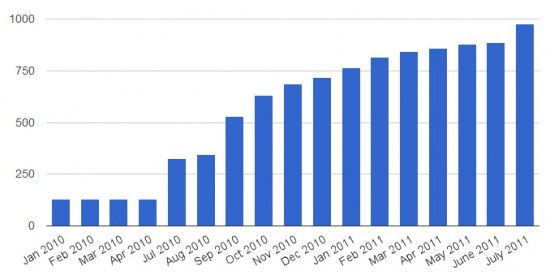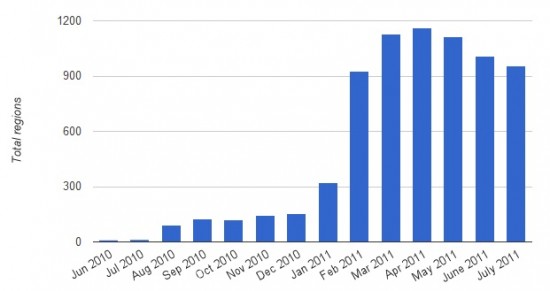It’s been a record-breaking months for OpenSim, with the top 40 grids passing 16,000 regions and 200,000 users for the first time in history.
The total number of regions on these 40 largest public grids was 16,959, an increase of 1,669 regions since mid June — the biggest single-month increase since we started tracking the numbers.
The total number of users is now 201,732, an increase of 7,266 users compared to the previous month.

Most growth
The two biggest gainers in region counts were OSGrid and ScienceSim, both non-profits that allow anyone to connect their own regions to the grid, including regions hosted on home computers. ScienceSim gained 671 regions, for a new total of 1,810 regions. OSGrid gained 622 regions, for a new total of 6,671.
Kitely gained 127 regions, for a new total of 905 regions. Kitely runs its regions on the Amazon EC2 cloud, putting regions into storage when nobody’s on them, and won’t begin billing for usage until August. Kitely also has the easiest interface for setting up new regions, allowing users to quickly spin up new empty regions, copies of existing regions, or create new regions based on saved OAR files.
InWorldz added 88 regions for a new total of 975, its biggest region gain since early last fall. InWorldz also relaunched its website recently and upgraded its server software, fixing a large number of bugs and improving performance.

But its chief commercial competitor, Avination, lost 51 regions for a new total of 957, continuing a downward slide that began in May.

Avination added the most new users, 2,557, bringing it to a total of 34,674 registered users. However, active 30-day users fell by 1,200 to 6,155. That could be a sign that people are signing up out of curiosity about the grid, but not staying long.
The slide in active user counts began in May — a month before region counts began dropping.

InWorldz added 1,391 new users for a new even total of 40,000 registered users. InWorldz does not release active 30-day user counts.
Avination and InWorldz are of particular interest because these are the two largest commercial grids running on the OpenSim software. Both have followed the Second Life model — no hypergrid access, limited or no export of regions or inventories, proprietary virtual currencies, and a focus on general purpose virtual socializing and role playing. Both have worked hard to attract merchants and to keep their content safe. Both charge $60 per region — a slight premium over the prices available on open grids from third party hosting providers, but reasonable given the work the grid managers put into building and maintaining communities and improving and customizing the grid software.
Although tiny by comparison to Second Life, these grids demonstrate that there is a potentially viable for small business owners who create niche grids and rent out land.
Since some hosting companies report that they make money by selling regions at $10 a month or less, even if Avination and InWorldz are spending $30 a month on servers and maintenance for their regions, that still leaves $30 per region of potential profit. This is reminiscent of the explosion in mom-and-pop Web hosting companies during the early years of the World Wide Web.
So it’s no surprise that more and more commercial grids are popping up all the time. New on the list this month, there’s the 254-region Grid Nirvana, which accepts new residents only by referral from existing members. There’s the gambling-oriented Virtual Games 3D, which has 149 regions. And Avatar Connection just launched with 17 regions and a focus on social networking.
“We felt that not all interactions and communications could be done in-world and our community pages bridge that gap,” grid founder Chris Holme told Hypergrid Business. “With just the one account name for grid and Web, the community features allow you to connect and communicate with your in world avatar friends when you or they are not in world. Our aim is to have a social network for your avatar. In real life you can have one, so why not your avatar?”

OSGrid added 1,196 new users, for a new total of 63,427 registered users, but active user numbers fell by 154 to 3,271 — possibly due to a drop in educational activities during the summer, or due to the fact that many OSGrid users actually have their avatars based on other grids, and teleport in via hypergrid for community events, shopping, and socializing.
Kitely soars
The cloud-based Kitely grid still lags behind other grids in functionality — no voice, no in-world teleports, no hypergrid, no currency or economy. Logins are still only via Facebook. And the billing system isn’t expected to go live until next month. Despite that, Kitely gained 127 regions over the past 30 days for a new high of 905 regions, and gained 174 new users for a new total of 1,106 registered users.
Part of the reason is that Kitely seems to have been discovered by educators and other non-profits as a quick, cheap, easy way to get a region up and running.
“There has been quite a lot of education-related activity on Kitely this month,” Kitely CEO Ilan Tochner told Hypergrid Business. “Virtual Worlds Education Roundtable held a field trip to Kitely, following which several dozen teachers opened Kitely worlds [regions].”

In addition, educators from non-English speaking countries have begun building their campuses on Kitely, he said.
“My Kitely vision presentation for MetaMeets [in Amsterdam] has gotten enthusiastic responses from quite a few teachers who want to see Kitely start providing immersive courseware on demand,” Tochner said. “We’ve also started getting additional interest from artists who are Second Life veterans and there is a small word-of-mouth effect that is slowly spreading in that community. All these things contributed to active user counts and total user-minutes going up.”
Kitely also added OAR exports, improved region load speeds, and made other improvements to the platform.
According to the Kitely roadmap, billing will be rolled out in August, at which point regions will cost 10 cents per month, with an addition 20 cents per visitor per hour. The 20 cents can be paid by either the region owner or by the visitor.
A few weeks after that, Kitely will roll out alternate login options, starting with Twitter, and followed by LinkedIn, Google, and other options. In-world and hypergrid teleports will come later, as will voice and other features.
Elsewhere in the Metaverse
There is currently no central system for tracking OpenSim grids. The OpenSimulator.org website does not track downloads, and grid owners don’t have to register their grids with anyone — unlike websites, where owners have to apply for domain names. The OpenSimulator grid list is out of date and incomplete.
If there’s a public grid we’re not tracking, please email us at editor@hypergridbusiness.com.
In addition, a single download of the server software can be used to set up several grids, or can be used to set up no grids at all.
However, there are statistics for one popular version of OpenSim, the Diva Distro, a four-region, hypergrid-enabled, pre-configured minigrid.
The Diva Distro has been downloaded 965 times over the past month, another record high. The total number of Diva Distro downloads now stands at 6,964.
Diva Distro is also part of the popular Sim-on-a-Stick, a version of OpenSim packaged to run on a USB stick. According to Sim-on-a-Stick creator Ener Hax, the USB-friendly OpenSim package has been downloaded 401 times over the past month — bringing the total of these downloads to more than 2,211.
Meanwhile, according to data from The Hypergates, there are now 534 active hypergates on 39 different grids, an increase of 41 gates over the previous month.
In addition, the number of people using the gates has grown, as has the number of hypergrid jumps. There were 5,816 hypergrid jumps made during the past four weeks, an increase of 1,613 over the previous month. And the number of hypergrid travelers increased as well, by 202 travelers, to 2,917, compared to the previous month.
Not all hypergates are part of The Hypergates network — anyone can create their own hypergrid by dropping a script on any object, such as our touch or walk-through single-destination hypergate script. In addition, many people do hypergrid jumps without using any gate at all, simply by typing a hypergrid address into Map-Search. There is currently no way of tracking that traffic.
Meanwhile, Second Life lost two  regions over the past month, and now has 31,238 regions, according to data from Grid Survey. This is a net lost of 573 regions since July of last year.
However, at nearly 800,000 average monthly repeat logins, Second Life throughly dwarfs any OpenSim-based grid when it comes to its active user base.
July Region Counts on the Top 40 Grids
We are now tracking a total of 165 different publicly-accessible grids, 83 of which reported their region counts this month. SpotOn3D did not report numbers for either its SpotOn3D or its Veesome grid.
The raw data for this month’s report is here.
- OSGrid: 6671 regions
- ScienceSim: 1810 regions
- InWorldz: 975 regions
- Avination: 957 regions
- Kitely: 905 regions
- Virtual Worlds Grid: 828 regions
- New World Grid: 691 regions
- AlphaTowne: 344 regions
- Metropolis: 341 regions
- FrancoGrid: 337 regions
- Grid Nirvana: 264 regions
- NexXtLife: 250 regions
- MyOpenGrid: 250 regions
- Craft World: 185 regions
- 3rd Rock Grid: 183 regions
- VirtualLife: 149 regions
- Virtual Games 3D: 149 regions
- Gay San Francisco: 127 regions
- Virtyou: 124 regions
- ReactionGrid: 115 regions
- Logicamp: 97 regions
- JokaydiaGrid: 95 regions
- Dorena’s World: 86 regions
- SIM World: 84 regions
- German Grid: 80 regions
- Slackdog Grid: 77 regions
- Nova Grid: 69 regions
- Twisted Sky: 69 regions
- Savage Grid: 69 regions
- AstralGrid: 68 regions
- Open Neuland: 67 regions
- OpenSim.ru: 59 regions
- PMGrid: 56 regions
- Pseudospace: 53 regions
- Avatar Hangout: 51 regions
- GerGrid: 50 regions
- TUIS: 49 regions
- Role Play Worlds: 45 regions
- Annuna Grid: 41 regions
- YourSimSpot: 39 regions
- OSCC 2024 Submission Deadline Approaching - October 19, 2024
- AvatarLife Viewer adds video calls, screen sharing - October 19, 2024
- Spooky season brings more visitors to OpenSim worlds - October 15, 2024
